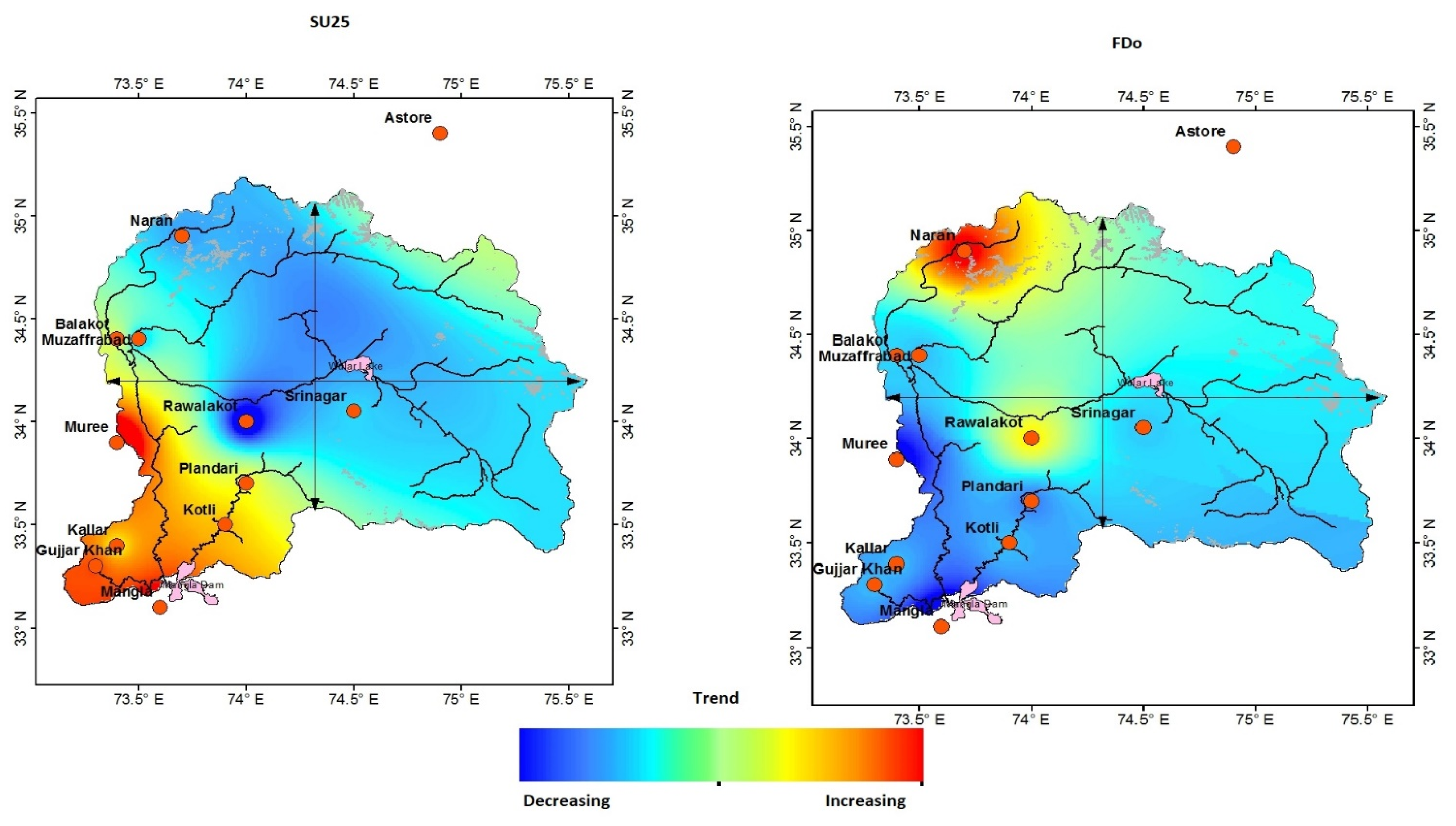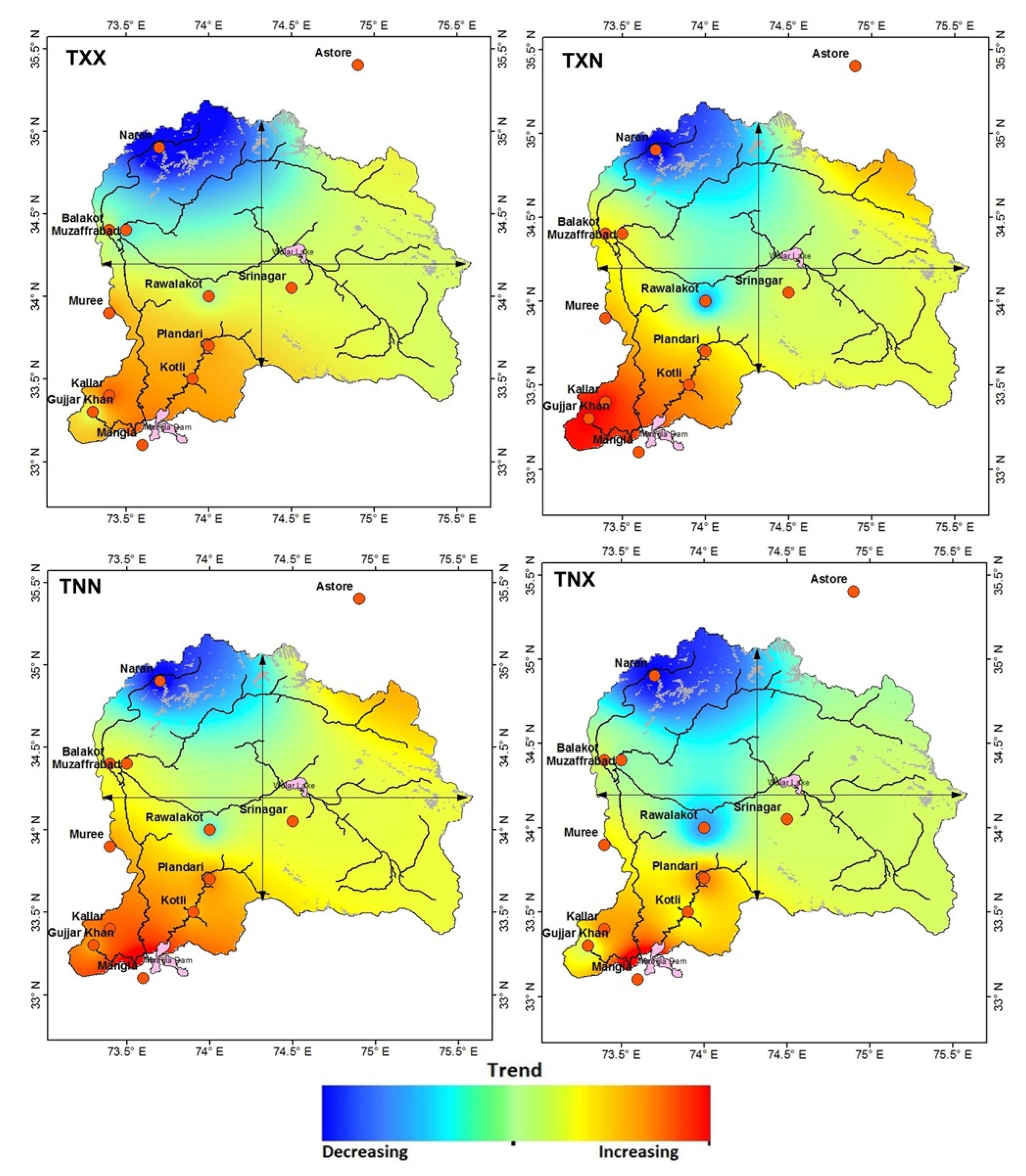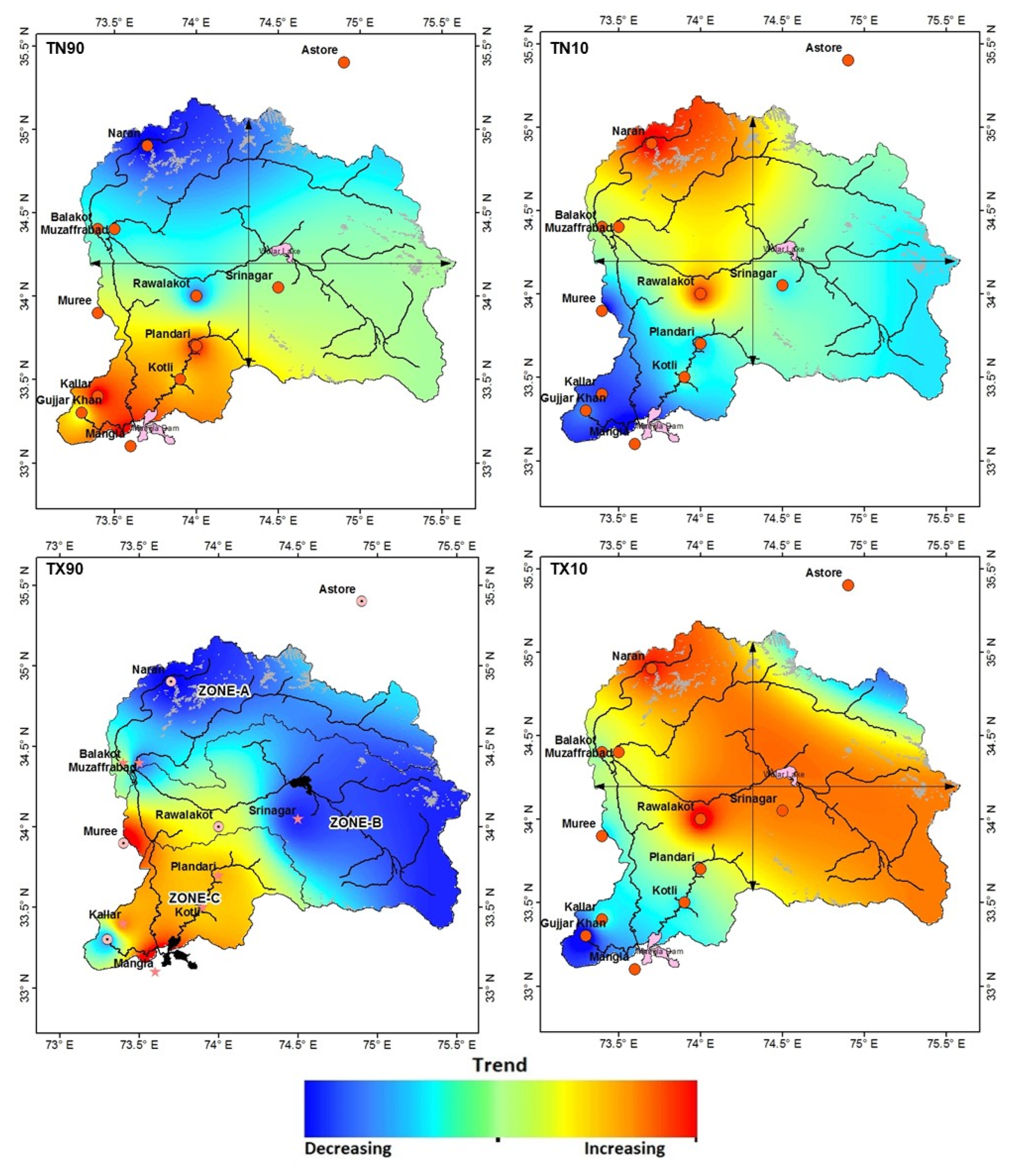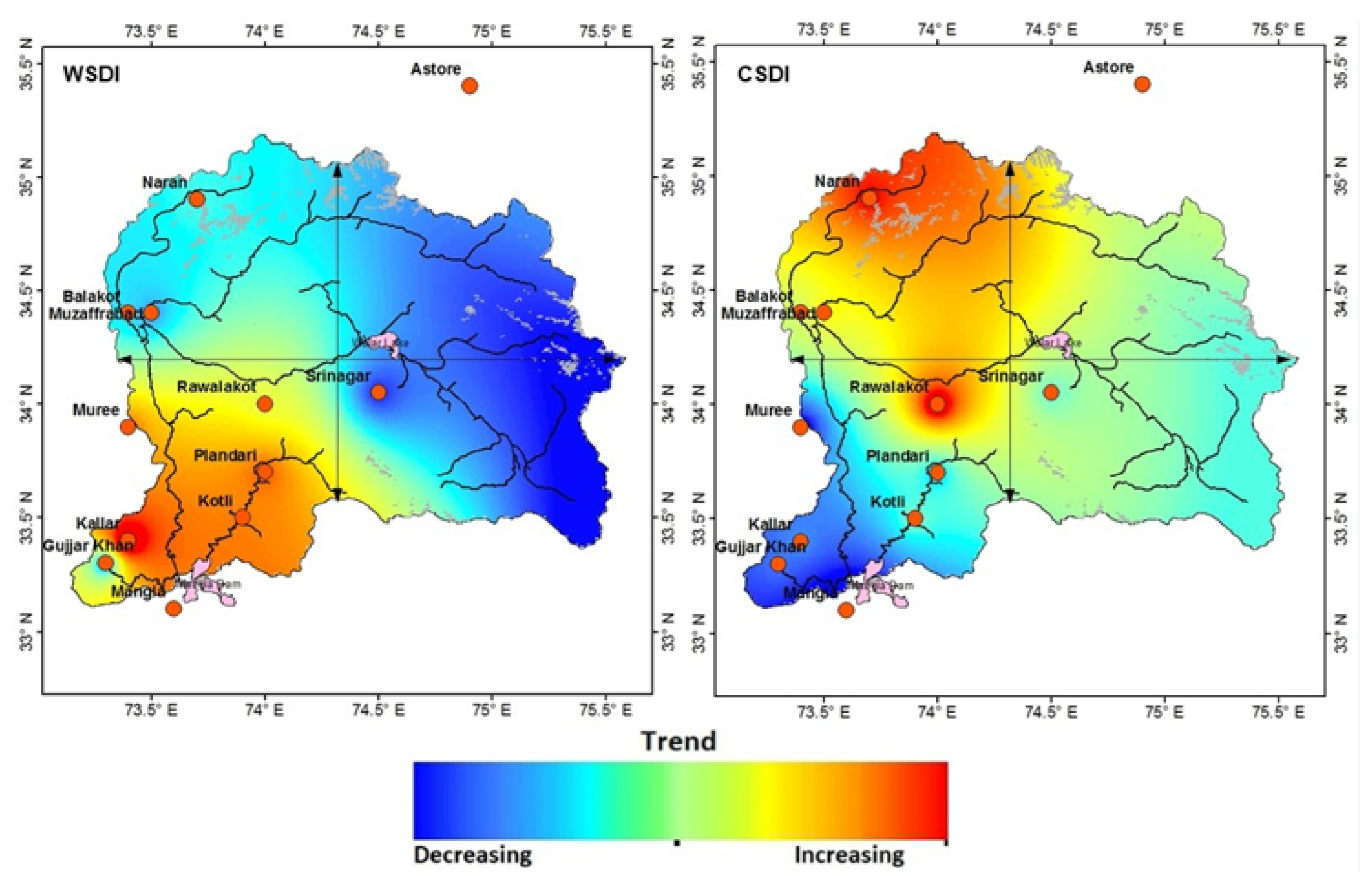Early 21st Century Trends of Temperature Extremes over the Northwest Himalayas
Abstract
1. Introduction
2. Study Area and Data Collection
3. Methodology
3.1. Data, Homogeneity Testing and Quality Control
3.2. Spatial Interpolation
4. Results and Discussion
4.1. Annual Max and Min Temperature
4.2. Temperature Absolute Indices
4.3. Temperature Extreme Value Indices
4.4. Frequency of Temperature Relative Indices
4.5. Warm and Cold Spells of Temperature
5. Conclusions
Author Contributions
Funding
Institutional Review Board Statement
Informed Consent Statement
Data Availability Statement
Conflicts of Interest
References
- Easterling, D.R.; Horton, B.; Jones, P.D.; Peterson, T.C.; Karl, T.R.; Parker, D.E.; Salinger, M.J.; Razuvayev, V.; Plummer, N.; Jamason, P. Maximum and minimum temperature trends for the globe. Science 1997, 277, 364–367. [Google Scholar] [CrossRef]
- Guan, Y.; Zhang, X.; Zheng, F.; Wang, B. Trends and variability of daily temperature extremes during 1960–2012 in the Yangtze River Basin, China. Glob. Planet. Chang. 2015, 124, 79–94. [Google Scholar] [CrossRef]
- Labat, D.; Goddéris, Y.; Probst, J.L.; Guyot, J.L. Evidence for global runoff increase related to climate warming. Adv. Water Resour. 2004, 27, 631–642. [Google Scholar] [CrossRef]
- Zhai, P.; Zhang, X.; Wan, H.; Pan, X. Trends in total rainfall and frequency of daily rainfall extremes over China. J. Clim. 2005, 18, 1096–1108. [Google Scholar] [CrossRef]
- Stocker, T.F.; Qin, D.; Plattner, G.-K.; Alexander, L.V.; Allen, S.K.; Bindoff, N.L.; Bréon, F.-M.; Church, J.A.; Cubasch, U.; Emori, S. Technical summary. In Climate Change 2013: The Physical Science Basis. Contribution of Working Group I to the Fifth Assessment Report of the Intergovernmental Panel on Climate Change; Cambridge University Press: Cambridge, UK, 2013; pp. 33–115. [Google Scholar]
- Legg, S. IPCC, 2021: Climate Change 2021-the Physical Science basis. Interaction 2021, 49, 44–45. [Google Scholar]
- Noaa, N. State of the Climate: Global Climate Report for Annual 2018. 2019. Available online: www.ncdc.noaa.gov/sotc/global/201813 (accessed on 2 February 2021).
- Sillmann, J.; Kharin, V.V.; Zwiers, F.; Zhang, X.; Bronaugh, D. Climate extremes indices in the CMIP5 multimodel ensemble: Part 2. Future climate projections. J. Geophys. Res. Atmos. 2013, 118, 2473–2493. [Google Scholar] [CrossRef]
- Goswami, U.P.; Bhargav, K.; Hazra, B.; Goyal, M.K. Spatiotemporal and joint probability behavior of temperature extremes over the Himalayan region under changing climate. Theor. Appl. Climatol. 2018, 134, 477–498. [Google Scholar] [CrossRef]
- Bhutiyani, M.; Kale, V.S.; Pawar, N. Long-term trends in maximum, minimum and mean annual air temperatures across the Northwestern Himalaya during the twentieth century. Clim. Chang. 2007, 85, 159–177. [Google Scholar] [CrossRef]
- Bhutiyani, M.R.; Kale, V.S.; Pawar, N. Climate change and the precipitation variations in the northwestern Himalaya: 1866–2006. Int. J. Climatol. A J. R. Meteorol. Soc. 2010, 30, 535–548. [Google Scholar] [CrossRef]
- Dimri, A.; Ganju, A. Wintertime seasonal scale simulation over Western Himalaya using RegCM3. Pure Appl. Geophys. 2007, 164, 1733–1746. [Google Scholar] [CrossRef]
- Dong-Qi, Z.; Cun-De, X.; Wei-Gang, L. Analysis on Himalayan climate change in 1951-2010. Adv. Clim. Chang. Res. 2012, 8, 110. [Google Scholar]
- Gautam, R.; Hsu, N.; Lau, K.M.; Tsay, S.C.; Kafatos, M. Enhanced pre-monsoon warming over the Himalayan-Gangetic region from 1979 to 2007. Geophys. Res. Lett. 2009, 36, L07704. [Google Scholar] [CrossRef]
- Lau, W.K.; Kim, M.-K.; Kim, K.-M.; Lee, W.-S. Enhanced surface warming and accelerated snow melt in the Himalayas and Tibetan Plateau induced by absorbing aerosols. Environ. Res. Lett. 2010, 5, 025204. [Google Scholar] [CrossRef]
- Sharma, K.P.; Moore, B.; Vorosmarty, C.J. Anthropogenic, climatic, and hydrologic trends in the Kosi Basin, Himalaya. Clim. Chang. 2000, 47, 141–165. [Google Scholar] [CrossRef]
- Yadav, R.R.; Park, W.K.; Singh, J.; Dubey, B. Do the western Himalayas defy global warming? Geophys. Res. Lett. 2004, 31, L17201. [Google Scholar] [CrossRef]
- Pepin, N.C.; Arnone, E.; Gobiet, A.; Haslinger, K.; Kotlarski, S.; Notarnicola, C.; Palazzi, E.; Seibert, P.; Serafin, S.; Schöner, W.; et al. Climate changes and their elevational patterns in the mountains of the world. Rev. Geophys. 2022, 60, e2020RG000730. [Google Scholar] [CrossRef]
- Dar, T.; Rai, N.; Kumar, S.; Bhat, M.A. Climate change impact on cryosphere and streamflow in the Upper Jhelum River Basin. Environ. Monit. Assess. 2022, 194, 140. [Google Scholar] [CrossRef]
- Shekhar, M.; Chand, H.; Kumar, S.; Srinivasan, K.; Ganju, A. Climate-change studies in the western Himalaya. Ann. Glaciol. 2010, 51, 105–112. [Google Scholar] [CrossRef]
- Dimri, A.; Dash, S. Wintertime climatic trends in the western Himalayas. Clim. Chang. 2012, 111, 775–800. [Google Scholar] [CrossRef]
- Revadekar, J.; Hameed, S.; Collins, D.; Manton, M.; Sheikh, M.; Borgaonkar, H.; Kothawale, D.; Adnan, M.; Ahmed, A.; Ashraf, J. Impact of altitude and latitude on changes in temperature extremes over South Asia during 1971–2000. Int. J. Climatol. 2013, 33, 199–209. [Google Scholar] [CrossRef]
- Chen, B.; Chao, W.C.; Liu, X. Enhanced climatic warming in the Tibetan Plateau due to doubling CO2: A model study. Clim. Dyn. 2003, 20, 401–413. [Google Scholar] [CrossRef]
- Liu, X.; Cheng, Z.; Yan, L.; Yin, Z.-Y. Elevation dependency of recent and future minimum surface air temperature trends in the Tibetan Plateau and its surroundings. Glob. Planet. Chang. 2009, 68, 164. [Google Scholar] [CrossRef]
- Pepin, N.; Bradley, R.; Diaz, H.; Baraer, M.; Caceres, E.; Forsythe, N.; Fowler, H.; Greenwood, G.; Hashmi, M.; Liu, X. Elevation-dependent warming in mountain regions of the world. Nat. Clim. Chang. 2015, 5, 424–430. [Google Scholar]
- Shrestha, A. Climate change in the Hindu Kush-Himalayas and its impacts on water and hazards. APMN Bull. 2009, 9, 1–5. [Google Scholar]
- Yan, L.; Liu, X. Has climatic warming over the Tibetan Plateau paused or continued in recent years. Earth Ocean Atmos. Sci. 2014, 1, 13–28. [Google Scholar]
- Yan, L.; Liu, Z.; Chen, G.; Kutzbach, J.; Liu, X. Mechanisms of elevation-dependent warming over the Tibetan plateau in quadrupled CO2 experiments. Clim. Chang. 2016, 135, 509–519. [Google Scholar] [CrossRef]
- Panday, P.K.; Thibeault, J.; Frey, K.E. Changing temperature and precipitation extremes in the Hindu Kush-Himalayan region: An analysis of CMIP3 and CMIP5 simulations and projections. Int. J. Climatol. 2015, 35, 3058–3077. [Google Scholar] [CrossRef]
- Alexander, L.V.; Zhang, X.; Peterson, T.C.; Caesar, J.; Gleason, B.; Klein Tank, A.; Haylock, M.; Collins, D.; Trewin, B.; Rahimzadeh, F. Global observed changes in daily climate extremes of temperature and precipitation. J. Geophys. Res. Atmos. 2006, 111, 1042–1063. [Google Scholar] [CrossRef]
- Donat, M.; Alexander, L.V.; Yang, H.; Durre, I.; Vose, R.; Dunn, R.J.; Willett, K.M.; Aguilar, E.; Brunet, M.; Caesar, J. Updated analyses of temperature and precipitation extreme indices since the beginning of the twentieth century: The HadEX2 dataset. J. Geophys. Res. Atmos. 2013, 118, 2098–2118. [Google Scholar] [CrossRef]
- Frich, P.; Alexander, L.V.; Della-Marta, P.; Gleason, B.; Haylock, M.; Tank, A.K.; Peterson, T. Observed coherent changes in climatic extremes during the second half of the twentieth century. Clim. Res. 2002, 19, 193–212. [Google Scholar] [CrossRef]
- Klein Tank, A.M.G.; Peterson, T.C.; Quadir, D.A.; Dorji, S.; Zou, X.; Tang, H.; Santhosh, K.; Joshi, U.R.; Jaswal, A.K.; Kolli, R.K.; et al. Changes in daily temperature and precipitation extremes in central and south Asia. J. Geophys. Res. Atmos. 2006, 111, D16105. [Google Scholar] [CrossRef]
- Manton, M.J.; Della-Marta, P.M.; Haylock, M.R.; Hennessy, K.; Nicholls, N.; Chambers, L.; Collins, D.; Daw, G.; Finet, A.; Gunawan, D. Trends in extreme daily rainfall and temperature in Southeast Asia and the South Pacific: 1961–1998. Int. J. Climatol. 2001, 21, 269–284. [Google Scholar] [CrossRef]
- Wang, B.; Zhang, M.; Wei, J.; Wang, S.; Li, S.; Ma, Q.; Li, X.; Pan, S. Changes in extreme events of temperature and precipitation over Xinjiang, northwest China, during 1960–2009. Quat. Int. 2013, 298, 141–151. [Google Scholar] [CrossRef]
- Almazroui, M.; Saeed, F.; Saeed, S.; Ismail, M.; Ehsan, M.A.; Islam, M.N.; Abid, M.A.; O’Brien, E.; Kamil, S.; Rashid, I.U. Projected changes in climate extremes using CMIP6 simulations over SREX regions. Earth Syst. Environ. 2021, 5, 481–497. [Google Scholar] [CrossRef]
- You, Q.; Kang, S.; Aguilar, E.; Yan, Y. Changes in daily climate extremes in the eastern and central Tibetan Plateau during 1961–2005. J. Geophys. Res. Atmos. 2008, 113, D07101. [Google Scholar] [CrossRef]
- Zhou, Y.; Ren, G. Change in extreme temperature event frequency over mainland China, 1961− 2008. Clim. Res. 2011, 50, 125–139. [Google Scholar] [CrossRef]
- Zahid, M.; Rasul, G. Frequency of extreme temperature and precipitation events in Pakistan 1965–2009. Sci. Int. 2011, 23, 313–319. [Google Scholar]
- Baidya, S.K.; Shrestha, M.L.; Sheikh, M.M. Trends in daily climatic extremes of temperature and precipitation in Nepal. J. Hydrol. Meteorol. 2008, 5, 38–51. [Google Scholar]
- Shrestha, A.B.; Bajracharya, S.R.; Sharma, A.R.; Duo, C.; Kulkarni, A. Observed trends and changes in daily temperature and precipitation extremes over the Koshi river basin 1975–2010. Int. J. Climatol. 2017, 37, 1066–1083. [Google Scholar] [CrossRef]
- Azmat, M.; Choi, M.; Kim, T.-W.; Liaqat, U.W. Hydrological modeling to simulate streamflow under changing climate in a scarcely gauged cryosphere catchment. Environ. Earth Sci. 2016, 75, 186. [Google Scholar] [CrossRef]
- Yaseen, M.; Rientjes, T.; Nabi, G.; Latif, M. Assessment of recent temperature trends in Mangla watershed. J. Himal. Earth Sci. 2014, 47, 107–121. [Google Scholar]
- Mahmood, R.; Jia, S. Spatial and temporal hydro-climatic trends in the transboundary Jhelum River basin. J. Water Clim. Chang. 2017, 8, 423–440. [Google Scholar] [CrossRef]
- Zhang, X.; Alexander, L.; Hegerl, G.C.; Jones, P.; Tank, A.K.; Peterson, T.C.; Trewin, B.; Zwiers, F.W. Indices for monitoring changes in extremes based on daily temperature and precipitation data. Wiley Interdiscip. Rev. Clim. Chang. 2011, 2, 851–870. [Google Scholar] [CrossRef]
- Aguilar, E.; Peterson, T.C.; Obando, P.R.; Frutos, R.; Retana, J.A.; Solera, M.; Soley, J.; García, I.G.; Araujo, R.M.; Santos, A.R.; et al. Changes in precipitation and temperature extremes in Central America and northern South America, 1961–2003. J. Geophys. Res. Atmos. 2005, 110, D23107. [Google Scholar] [CrossRef]
- Peterson, T.C.; Taylor, M.A.; Demeritte, R.; Duncombe, D.L.; Burton, S.; Thompson, F.; Porter, A.; Mercedes, M.; Villegas, E.; Semexant Fils, R. Recent changes in climate extremes in the Caribbean region. J. Geophys. Res. Atmos. 2002, 107, 4601. [Google Scholar] [CrossRef]
- Dereje, A.; Kindie, T.; Girma, M.; Birru, Y.; Wondimu, B. Variability of rainfall and its current trend in Amhara region, Ethiopia. Afr. J. Agric. Res. 2012, 7, 1475–1486. [Google Scholar] [CrossRef]
- Duhan, D.; Pandey, A. Statistical analysis of long term spatial and temporal trends of precipitation during 1901–2002 at Madhya Pradesh, India. Atmos. Res. 2013, 122, 136–149. [Google Scholar] [CrossRef]
- Shafiq, M.U.; Rasool, R.; Ahmed, P.; Dimri, A. Temperature and precipitation trends in Kashmir Valley, north western Himalayas. Theor. Appl. Climatol. 2019, 135, 293–304. [Google Scholar] [CrossRef]
- Sheikh, M.; Manzoor, N.; Ashraf, J.; Adnan, M.; Collins, D.; Hameed, S.; Manton, M.; Ahmed, A.; Baidya, S.; Borgaonkar, H. Trends in extreme daily rainfall and temperature indices over South Asia. Int. J. Climatol. 2015, 35, 1625–1637. [Google Scholar] [CrossRef]
- Sun, W.; Mu, X.; Song, X.; Wu, D.; Cheng, A.; Qiu, B. Changes in extreme temperature and precipitation events in the Loess Plateau (China) during 1960–2013 under global warming. Atmos. Res. 2016, 168, 33–48. [Google Scholar] [CrossRef]
- You, Q.-L.; Ren, G.-Y.; Zhang, Y.-Q.; Ren, Y.-Y.; Sun, X.-B.; Zhan, Y.-J.; Shrestha, A.B.; Krishnan, R. An overview of studies of observed climate change in the Hindu Kush Himalayan (HKH) region. Adv. Clim. Chang. Res. 2017, 8, 141–147. [Google Scholar] [CrossRef]
- Khan, N.; Shahid, S.; Ismail, T.b.; Wang, X.-J. Spatial distribution of unidirectional trends in temperature and temperature extremes in Pakistan. Theor. Appl. Climatol. 2019, 136, 899–913. [Google Scholar] [CrossRef]
- Maenza, R.A.; Agosta, E.A.; Bettolli, M.L. Climate change and precipitation variability over the western ‘Pampas’ in Argentina. Int. J. Climatol. 2017, 37, 445–463. [Google Scholar] [CrossRef]
- Priya, P.; Krishnan, R.; Mujumdar, M.; Houze, R.A. Changing monsoon and midlatitude circulation interactions over the Western Himalayas and possible links to occurrences of extreme precipitation. Clim. Dyn. 2017, 49, 2351–2364. [Google Scholar] [CrossRef]
- Wang, P.X.; Wang, B.; Cheng, H.; Fasullo, J.; Guo, Z.; Kiefer, T.; Liu, Z. The global monsoon across time scales: Mechanisms and outstanding issues. Earth-Sci. Rev. 2017, 174, 84–121. [Google Scholar] [CrossRef]
- Wang, S.Y.; Davies, R.E.; Huang, W.R.; Gillies, R.R. Pakistan’s two-stage monsoon and links with the recent climate change. J. Geophys. Res. Atmos. 2011, 116, D16114. [Google Scholar] [CrossRef]
- Fujita, K.; Nakawo, M.; Fujii, Y.; Paudyal, P. Changes in glaciers in hidden valley, Mukut Himal, Nepal Himalayas, from 1974 to 1994. J. Glaciol. 1997, 43, 583–588. [Google Scholar] [CrossRef]
- Kadota, T.; Ageta, Y. On the relation between climate and retreat of Glacier AX010 in the Nepal Himalaya from 1978 to 1989. Bull. Glacier Res. 1992, 10, 1–10. [Google Scholar]






| Sr. No. | Stations | Latitude [43] | Longitude [43] | Elevation (m.a.s.l) |
|---|---|---|---|---|
| 1 | ASTORE | 35.4 | 74.9 | 2168 |
| 2 | NARAN | 34.9 | 73.7 | 2363 |
| 3 | BALAKOT | 34.4 | 73.4 | 995.5 |
| 4 | MUZAFFARABAD | 34.4 | 73.5 | 702 |
| 5 | MURREE | 33.9 | 73.4 | 2206 |
| 6 | RAWALAKOT | 34.0 | 74.0 | 1677 |
| 7 | PALANDRI | 33.7 | 73.7 | 1402 |
| 8 | KOTLI | 33.5 | 73.9 | 610 |
| 9 | KALLAR | 33.4 | 73.4 | 518 |
| 10 | GUJJAR KHAN | 33.3 | 73.3 | 457 |
| 11 | MANGLA | 33.1 | 73.6 | 282 |
| 12 | SRINAGAR | 34.1 | 74.5 | 1587 |
| Indices Group | Description | Unit | |
|---|---|---|---|
| Annual Max/Min Temperature | |||
| TMAX | Annual maximum temperature | Annual maximum value of temperature | °C |
| TMIN | Annual minimum temperature | Annual minimum value of temperature | °C |
| Absolute Indices | Day | ||
| FD | Frost days | Year Tn (Lowest temperature of the day) < 0 °C | Day |
| SU25 | Summer days | Year TX (highest temperature of the day) > 25 °C | |
| Extreme Value Indices | |||
| TXx | Maximum TX | Monthly maximum value of TX | °C |
| TNx | Maximum TN | Monthly minimum value of TX | °C |
| TXn | Minimum TX | Monthly maximum value of TN | °C |
| TNn | Minimum TN | Monthly minimum value of TN | °C |
| Relative Indices | |||
| TN10p | Cool nights | Percentage of days when TN < 10th | Day |
| TX10p | Cool days | Percentage of days when TX < 10th percentile | Day |
| TN90p | Warm nights | Percentage of days when TN > 90th percentile | Day |
| TX90p | Warm days | Percentage of days when TX > 90th percentile | Day |
| Extreme Spell’s Indices | |||
| CSDI | Cold spell duration index | Annual count of days with at least 6 consecutive days when TN < 10th percentile | Day |
| WSDI | Warm spell duration index | Annual count of days with at least 6 consecutive days when TX > 90th percentile | Day |
| Stations | Tmax | Tmin | ||
|---|---|---|---|---|
| Slope (C/Decade) | Trend | Slope (C/Decade) | Trend | |
| Astore | −0.03 | NSF | −0.04 | NSF |
| Balakot | −0.02 | NSF | −0.01 | NSF |
| Gujjar Khan | 0.00 | NSF | 0.02 | NSF |
| Kallar | −0.02 | NSF | 0.31 | SSF |
| Kotli | 0.00 | NSF | 0.03 | NSF |
| Mangla | 0.09 | SSF | 0.91 | VSSF |
| Murree | 0.07 | NSF | 0.21 | VSSF |
| Muzaffrabad | −0.17 | VSSF | −0.07 | SSF |
| Naran | −0.54 | VSSF | −0.74 | SSF |
| Plandari | −0.02 | NSF | 0.22 | SSF |
| Rawalakot | −0.46 | SSF | −0.53 | SSF |
| Srinagar | −0.14 | VSSF | 0.02 | NSF |
| Stations | SU25 | FDo | ||
|---|---|---|---|---|
| Slope (Days/Decade) | Trend | Slope (Days/Decade) | Trend | |
| Astore | −1.44 | VSSF | 0.17 | NSF |
| Balakot | −1.01 | WSF | 0.30 | NSF |
| Gujjar Khan | −0.12 | NSF | −0.15 | NSF |
| Kallar | −1.41 | NSF | −0.20 | NSF |
| Kotli | −0.70 | NSF | −0.07 | NSF |
| Mangla | 0.75 | NSF | −7.18 | VSSF |
| Murree | 1.93 | NSF | −4.02 | VSSF |
| Muzaffrabad | −2.67 | SSF | −0.09 | NSF |
| Naran | −2.48 | NSF | 10.11 | SSF |
| Plandari | −0.87 | NSF | −1.13 | SSF |
| Rawalakot | −4.44 | WSF | 5.62 | VSSF |
| Srinagar | −2.19 | VSSF | 0.15 | NSF |
| Stations | TXX Warmest Day | TXN Coldest Day | TNX Warmest Night | TNN Coldest Night | ||||
|---|---|---|---|---|---|---|---|---|
| Slope (C/Year) | Trend | Slope (C/Year) | Trend | Slope (C/Year) | Trend | Slope (C/Year) | Trend | |
| Astore | −0.06 | NSF | 0.09 | NSF | −0.12 | SSF | 0.19 | WSF |
| Balakot | −0.05 | NSF | 0.04 | NSF | 0.02 | NSF | 0.00 | NSF |
| Gujjar Khan | −0.15 | NSF | 0.29 | SSF | −0.01 | NSF | 0.10 | NSF |
| Kallar | 0.09 | NSF | 0.31 | VSSF | 0.32 | VSSF | 0.32 | VSSF |
| Kotli | 0.00 | NSF | 0.16 | NSF | 0.11 | NSF | 0.12 | NSF |
| Mangla | 0.10 | NSF | 0.26 | SSF | 1.03 | VSSF | 0.90 | VSSF |
| Murree | 0.04 | NSF | 0.08 | NSF | 0.13 | NSF | 0.22 | VSSF |
| Muzaffrabad | −0.22 | SSF | −0.10 | NSF | −0.16 | SSF | 0.02 | NSF |
| Naran | −0.41 | SSF | −0.81 | SSF | −0.70 | VSSF | −0.83 | VSSF |
| Plandari | 0.02 | NSF | 0.05 | NSF | 0.35 | SSF | 0.30 | SF |
| Rawalakot | −0.15 | NSF | −0.66 | VSSF | −0.45 | VSSF | −0.40 | SSF |
| Srinagar | −0.09 | SSF | −0.11 | NSF | 0.00 | NSF | −0.02 | NSF |
| Stations | TX90 (Warm Day) | TN90 (Warm Night) | TX10 (Cold Day) | TN10 (Cold Night) | ||||
|---|---|---|---|---|---|---|---|---|
| Slope (Days/Year) | Trend | Slope (Days/Year) | Trend | Slope (Days/Year) | Trend | Slope (Days/Year) | Trend | |
| Astore | −0.49 | WSF | −0.60 | VSSF | −0.32 | SSF | −0.03 | NSF |
| Balakot | −0.10 | NSF | −0.08 | NSF | 0.07 | NSF | −0.05 | NSF |
| Gujjar Khan | −0.69 | SSF | −0.10 | NSF | −0.90 | NSF | −0.52 | SSF |
| Kallar | 0.46 | NSF | 2.40 | VSSF | 0.39 | NSF | −1.04 | SSF |
| Kotli | 0.25 | NSF | 0.65 | NSF | −0.02 | NSF | 0.02 | NSF |
| Mangla | 1.29 | VSSF | 2.74 | VSSF | −0.15 | NSF | −2.19 | VSSF |
| Murree | 0.83 | NSF | 0.60 | SSF | −0.10 | NSF | −1.57 | VSSF |
| Muzaffrabad | −0.81 | VSSF | −0.57 | VSSF | 0.64 | SSF | 0.53 | VSSF |
| Naran | −1.05 | NSF | −1.61 | VSSF | 1.09 | SSF | 1.38 | SSF |
| Plandari | 0.31 | NSF | 2.25 | SSF | 0.27 | NSF | −0.71 | VSSF |
| Rawalakot | 0.04 | NSF | −1.45 | SSF | 1.48 | SSF | 1.67 | SSF |
| Srinagar | −0.99 | VSSF | 0.08 | NSF | 0.85 | VSSF | −0.40 | SSF |
| Stations | WSDI | CDSI | ||
|---|---|---|---|---|
| Slope (Days/Year) | Trend | Slope (Days/Year) | Trend | |
| Astore | −0.20 | NSF | 0.12 | NSF |
| Balakot | 0.17 | NSF | 0.03 | NSF |
| Gujjar Khan | −1.03 | VSSF | −0.97 | NSF |
| Kallar | 5.09 | NSF | −0.78 | NSF |
| Kotli | 2.56 | NSF | −0.14 | NSF |
| Mangla | 2.90 | VSSF | −3.19 | VSSF |
| Murree | 2.80 | NSF | −2.09 | VSSF |
| Muzaffrabad | −0.47 | WSF | 0.65 | SSF |
| Naran | 0.50 | NSF | 1.55 | NSF |
| Plandari | 3.03 | NSF | −0.84 | NSF |
| Rawalakot | 1.46 | NSF | 2.52 | SSF |
| Srinagar | −1.11 | VSSF | −0.40 | NSF |
Disclaimer/Publisher’s Note: The statements, opinions and data contained in all publications are solely those of the individual author(s) and contributor(s) and not of MDPI and/or the editor(s). MDPI and/or the editor(s) disclaim responsibility for any injury to people or property resulting from any ideas, methods, instructions or products referred to in the content. |
© 2023 by the authors. Licensee MDPI, Basel, Switzerland. This article is an open access article distributed under the terms and conditions of the Creative Commons Attribution (CC BY) license (https://creativecommons.org/licenses/by/4.0/).
Share and Cite
Rahim, A.; Wang, X.; Javed, N.; Aziz, F.; Jahangir, A.; Khurshid, T. Early 21st Century Trends of Temperature Extremes over the Northwest Himalayas. Atmosphere 2023, 14, 454. https://doi.org/10.3390/atmos14030454
Rahim A, Wang X, Javed N, Aziz F, Jahangir A, Khurshid T. Early 21st Century Trends of Temperature Extremes over the Northwest Himalayas. Atmosphere. 2023; 14(3):454. https://doi.org/10.3390/atmos14030454
Chicago/Turabian StyleRahim, Akif, Xiuquan Wang, Neelam Javed, Farhan Aziz, Amina Jahangir, and Tahira Khurshid. 2023. "Early 21st Century Trends of Temperature Extremes over the Northwest Himalayas" Atmosphere 14, no. 3: 454. https://doi.org/10.3390/atmos14030454
APA StyleRahim, A., Wang, X., Javed, N., Aziz, F., Jahangir, A., & Khurshid, T. (2023). Early 21st Century Trends of Temperature Extremes over the Northwest Himalayas. Atmosphere, 14(3), 454. https://doi.org/10.3390/atmos14030454






